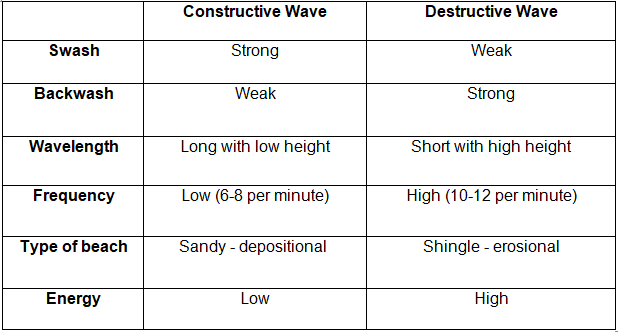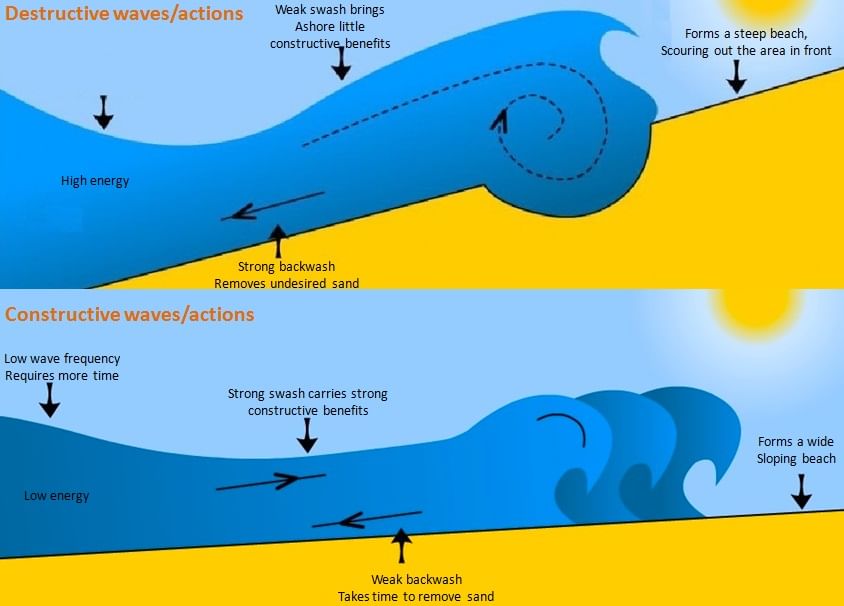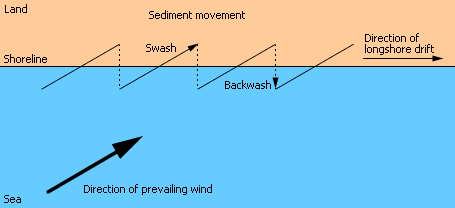Class 10 Exam > Class 10 Notes > Geography for GCSE/IGCSE > Coastal Processes
Coastal Processes | Geography for GCSE/IGCSE - Class 10 PDF Download
| Table of contents |

|
| Coastal regions |

|
| Waves |

|
| Marine erosion |

|
| Marine Transportation |

|
| Marine Deposition |

|
Coastal regions
In coastal areas, several key concepts shape the interaction between land and sea:
- Coast: This term refers to the meeting point of land and sea.
- Coastline: It defines the edge of the land, indicated by the high-water mark on low-lying coasts or the base of steep slopes.
- Shore: The shore encompasses the region between the lowest and highest tide marks.
- Tides: These natural phenomena occur approximately twice daily, showing variations based on location and time of year.
- Tidal Range: The tidal range highlights the contrast between low and high tide levels.
- Waves: The movement of waves and currents plays a significant role in shaping coastal features.
Waves
- Waves in the ocean are processes responsible for wearing away, moving, and depositing materials.
- They are generated when wind blows across the surface of the sea.
- The size of a wave is influenced by:
- The speed of the wind.
- The fetch, which is the distance over which the wind travels.
- The duration for which the wind blows consistently in one direction.
- Greater wind strength, longer durations, and increased fetch result in larger waves.
- When a wave nears the coast and encounters shallower water, friction with the seabed causes it to incline forward, leading to the wave cresting and breaking on the shore.
- The forward movement of water up the beach is known as the swash, while the backward movement is termed the backwash.
Key Factors Affecting Wave Size:
- Speed: Refers to how fast the wind is blowing.
- Fetch: Represents the distance traveled by the wind.
- Time: Signifies the duration for which the wind blows in a consistent direction.
Types of Waves
- Destructive waves: These waves erode the beach due to their short wavelength, high-frequency rate, and steep wave gradient. The backwash of destructive waves is stronger than their swash, leading to the removal of material out to sea.
- Constructive waves: Unlike destructive waves, constructive waves are beach builders. They possess a long wavelength, low-frequency rate, and a shallow wave gradient. The swash of constructive waves is stronger than their backwash, resulting in the transportation and deposition of material onto the beach.
Comparison of Wave Type


Question for Coastal ProcessesTry yourself: What factors influence the size of waves in coastal areas?View Solution
Marine erosion
- Destructive waves are the primary agents of coastal erosion.
- They erode coastlines through four main processes: Hydraulic Action, Attrition, Corrosion, and Abrasion.
- The impact of attrition intensifies when waves transport sediment over longer distances and durations.
- Over time and with increased water exposure, large, coarse boulders gradually erode into rounded sand grains, primarily composed of quartz.
- Rounded pebbles found on beaches are commonly referred to as shingle.
Marine Transportation
- The ocean transports sediment much like a river, receiving material from various sources:
- Erosion from cliffs
- Transport via longshore drift along the coastline
- Carried inland from offshore by constructive waves
- Conveyed to the coastline by rivers
- Once in the water, the material is transported through different mechanisms:
- Traction
- Saltation
- Suspension
- Solution
Longshore Drift
- This process serves as the primary mode of transportation along the coastline.
- Wave direction is influenced by prevailing winds, causing waves to approach the beach at an oblique angle.
- Upon breaking, the swash carries material up the beach at the same oblique angle.
- Subsequently, the backwash carries the material down the beach perpendicular to the shoreline (at a 90° angle).
- This cycle repeats, resulting in the transportation of material along the beach in a zigzag pattern.

- Along coasts with consistent longshore drift in a particular direction, beach sediment is transported over longer distances.
- When sediment movement is obstructed, it prevents sediment from reaching areas further down the coast.
- This creates two problems:
a. Reduction in the size of beaches, making them less appealing to tourists and resulting in income loss.
b. Diminishing natural coastal defenses.
Marine Deposition
- Waves transport sand or shingle as they move.
- Swash carries sediment onto the beach, while backwash carries it away.
- Constructive waves deposit larger material along the upper reach of the swash as they carry sediment up the beach.
- As the backwash returns down the beach, it loses energy due to water loss through the sand's porosity.
- Consequently, sediment deposition becomes progressively smaller, resulting in the beach being sorted by wave deposition, with the finest particles settling offshore in low-energy environments.
- During storms with destructive waveforms, large shingle is thrown above the typical high tide level, forming a ridge known as a berm at the beach's top.

Question for Coastal ProcessesTry yourself: What are the primary mechanisms of marine erosion?View Solution
The document Coastal Processes | Geography for GCSE/IGCSE - Class 10 is a part of the Class 10 Course Geography for GCSE/IGCSE.
All you need of Class 10 at this link: Class 10
|
55 videos|68 docs|78 tests
|
FAQs on Coastal Processes - Geography for GCSE/IGCSE - Class 10
| 1. How do waves contribute to marine erosion in coastal regions? |  |
Ans. Waves contribute to marine erosion in coastal regions by constantly hitting the shoreline with their force, which gradually wears away the land. The energy from the waves breaks down rock formations and carries away particles, leading to the erosion of the coast.
| 2. What role does marine transportation play in coastal regions? |  |
Ans. Marine transportation is essential in coastal regions as it provides an efficient way to transport goods and people between different locations. Ports in coastal regions serve as hubs for shipping and receiving goods, contributing to the economy of the area.
| 3. How does marine deposition impact the formation of coastal landforms? |  |
Ans. Marine deposition occurs when sediment carried by rivers or waves settles along the shoreline, gradually building up landforms such as beaches, spits, and barrier islands. This process shapes the coastal landscape and creates habitats for various marine species.
| 4. What are some strategies to mitigate the effects of marine erosion in coastal regions? |  |
Ans. Some strategies to mitigate the effects of marine erosion in coastal regions include building seawalls or breakwaters to protect the shoreline, planting vegetation to stabilize the coast, and implementing beach nourishment projects to replenish eroded areas with sand.
| 5. How do tides influence coastal processes in marine environments? |  |
Ans. Tides play a significant role in coastal processes by causing the water level to rise and fall periodically. This movement of water affects erosion, deposition, and marine transportation along the coast, shaping the dynamics of coastal ecosystems.
Related Searches




















